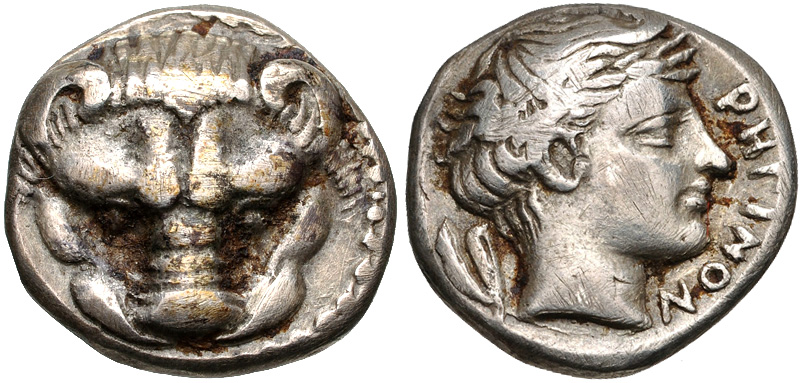410 BCE - 368 BCE | KAMΠΑΝΩΝ
Overstriking coin
SO_133_-_Entella_(drachm).jpg
[1]
Overstruck variety
Rhegium_HN_Italy_2497.jpeg
[2]
|
|
Sale(s)Sale(s) ᵖ:
|
Gemini, 6, 10 Jan. 2010, 16 = Nomos, 33, 9 June 2024, 1020
|
| Private collection(s)Private collection(s) ᵖ:
|
The Jonathan H. Kagan Collection of Ancient Greek Coins
|
|
Description
| ObverseInscription or printing placed on the obverse.:
|
Horse galloping right, over corn grain.
|
ReverseInscription or printing placed on the reverse.:
|
KAMΠΑΝΩΝ (Greek) Campanian helmet left.
|
Mint and issuing power
| MintIdentifies the place of manufacture or issue of a numismatic object.:
|
Entella
|
Ancient regionAncient region.
|
Sicily
|
Modern countryModern country: Italy
|
AuthorityIdentifies the issuing power. The authority can be "pretended" when the name or the portrait of X is on the coin but he/she was not the issuing power. It can also be "uncertain" when there is no mention of X on the coin but he/she was the issuing power according to the historical sources:
|
|
Chronology
| FromIdentifies the initial date in a range assigned in a numismatic context. 410 BCE toIdentifies the final date in a range assigned in a numismatic context.. 368 BCE
|
Classical 480-323 BC  periodTime period of the numismatic object. periodTime period of the numismatic object.
|
Physical description
MetalThe physical material (usually metal) from which an object is made.: Silver 
|
WeightWeight of the numismatic object (in grams). in grams: 3.983.98 g <br />3,980 mg <br />
|
DenominationTerm indicating the value of a numismatic object. Examples: tetradrachm, chalkous, denarius.: drachma 
|
AxisDescribes the directional relationship between the obverse and reverse of a numismatic object.: 22 mm <br />0.2 cm <br />
|
| DiameterDescribes diameter of an object (in mm).: 1717 mm <br />1.7 cm <br />
|
StandardStandard.: Attic
|
References
Description
| ObverseInscription or printing placed on the obverse.:
|
Lion scalp facing
|
ReverseInscription or printing placed on the reverse.:
|
PHΓΙΝΩΝ (Greek) Head of Apollo
|
Mint and issuing power
| MintIdentifies the place of manufacture or issue of a numismatic object. ᵖ:
|
Rhegium
|
Ancient regionAncient region. ᵖ
|
Bruttium
|
Modern countryModern country: Italy
|
AuthorityIdentifies the authority in whose name (explicitly or implicitly) a numismatic object was issued. ᵖ:
|
|
Chronology
| FromIdentifies the initial date in a range assigned in a numismatic context. 415 BCE toIdentifies the final date in a range assigned in a numismatic context.. 387 BCE
|
Classical 480-323 BC  periodTime period of the numismatic object. periodTime period of the numismatic object.
|
Physical description
| DenominationTerm indicating the value of a numismatic object. Examples: tetradrachm, chalkous, denarius. ᵖ:
|
drachma 
|
StandardStandard. ᵖ:
|
Attic
|
References
| Frequency of overstrikesFrequency of overstrikes:
|
rare and spread
|
Level of confidenceLevel of confidence of the identification:
|
sure
|
| RemarksRemarks:
|
"Clearly overstruck on a drachm of Rhegium (of Herzfelder type 105-116). This coin is possibly the only one overstruck on this type"; "The types of the Kampanoi are struck over a clearly recognisable drachm of Rhegion (cf. Herzfelder 105-116). When Lee produced his corpus the Rhegiontine under type was unknown: it would be interesting to try ascertain whether the reverse die used for this coin was also used for the rare bronzes struck at the same time (as Buceti 9)."
|
References
- ^ Lee, Ian (2000), "Entella: The Silver Coinage of the Campanian Mercenaries and the Site of the First Carthaginian Mint 410-409 BC", Numismatic Chronicle, 160, p. 1-66, pl. 1-3.
- ^ Hoover, Oliver D. (2012), The Handbook of Greek Coinage Series. 2. Handbook of the Coins of Sicily (Including Lipara). Civic, Royal, Siculo-Punic, and Romano-Sicilian Issues. Sixth to First Centuries BC, Lancaster-London, 489 p.
- ^ Herzfelder, Hubert (1957), Les monnaies d’argent de Rhégion frappées entre 461 et le milieu du IVe siècle av. J.-C., Paris, 1957, 154 p., 20 pl.
- ^ SNG ANS 3 Sicily
- ^ Rutter N. Keith et alii (eds.) (2001), Historia Numorum Italy, London, xvi, 223 p., 43 pl.

